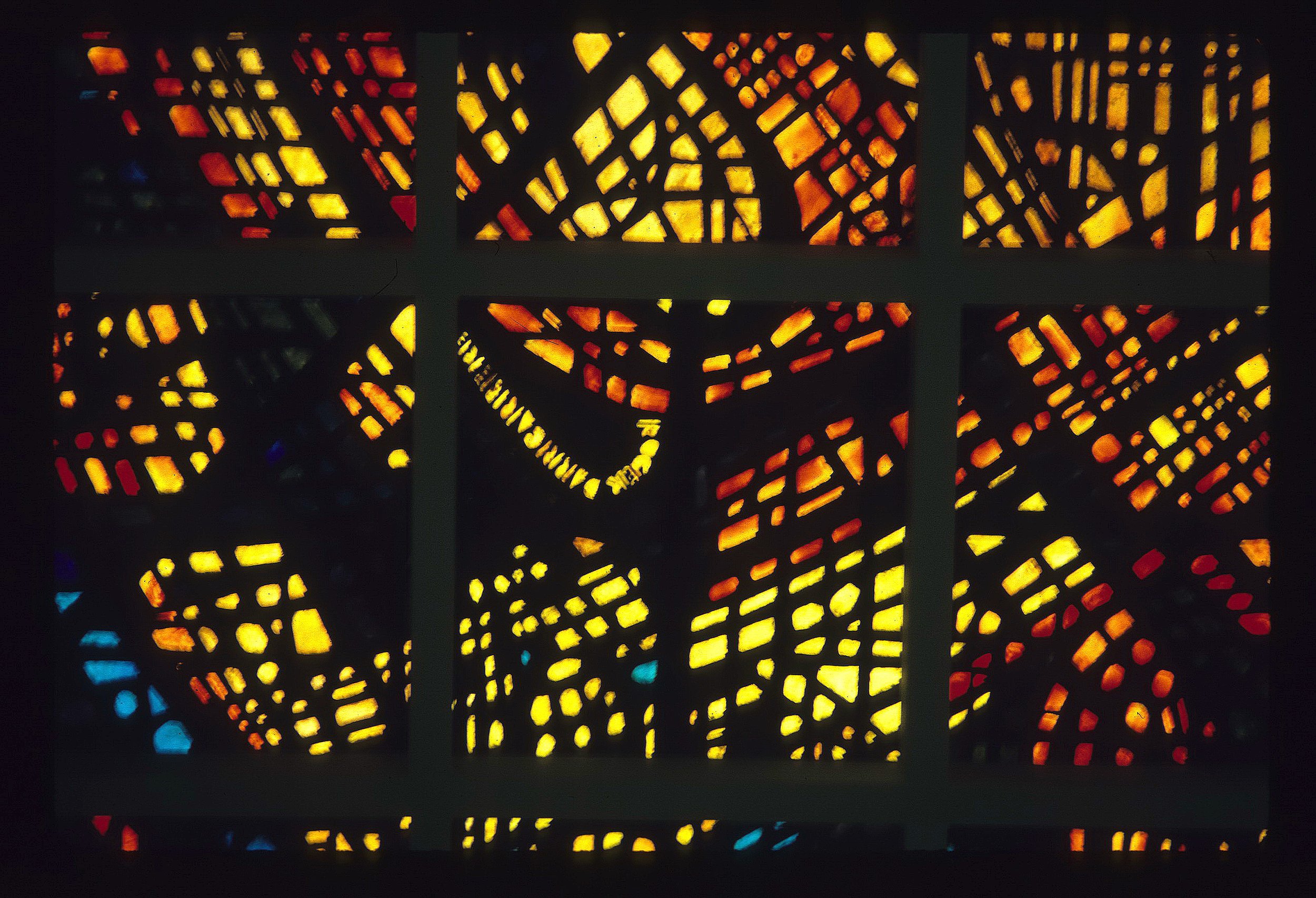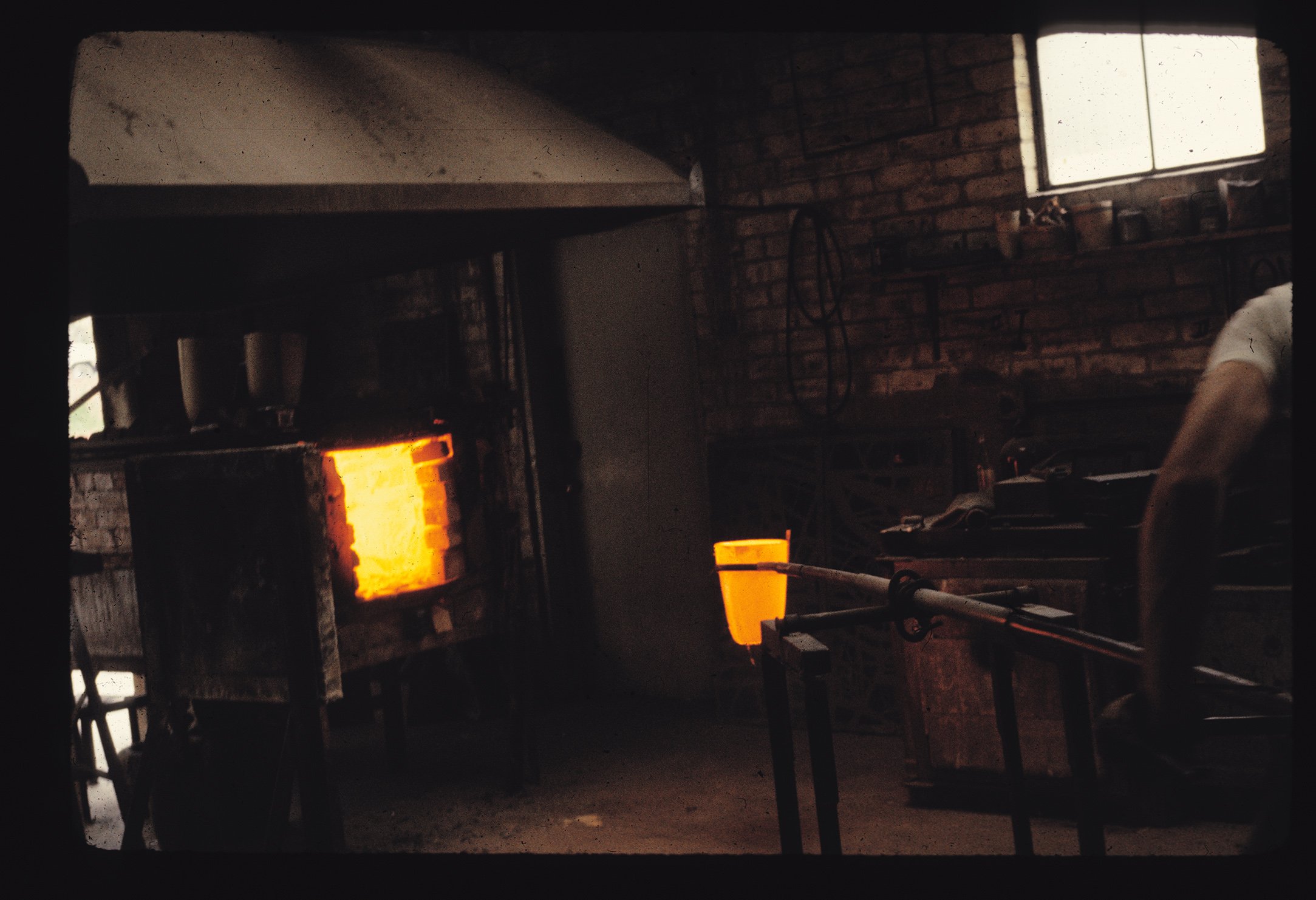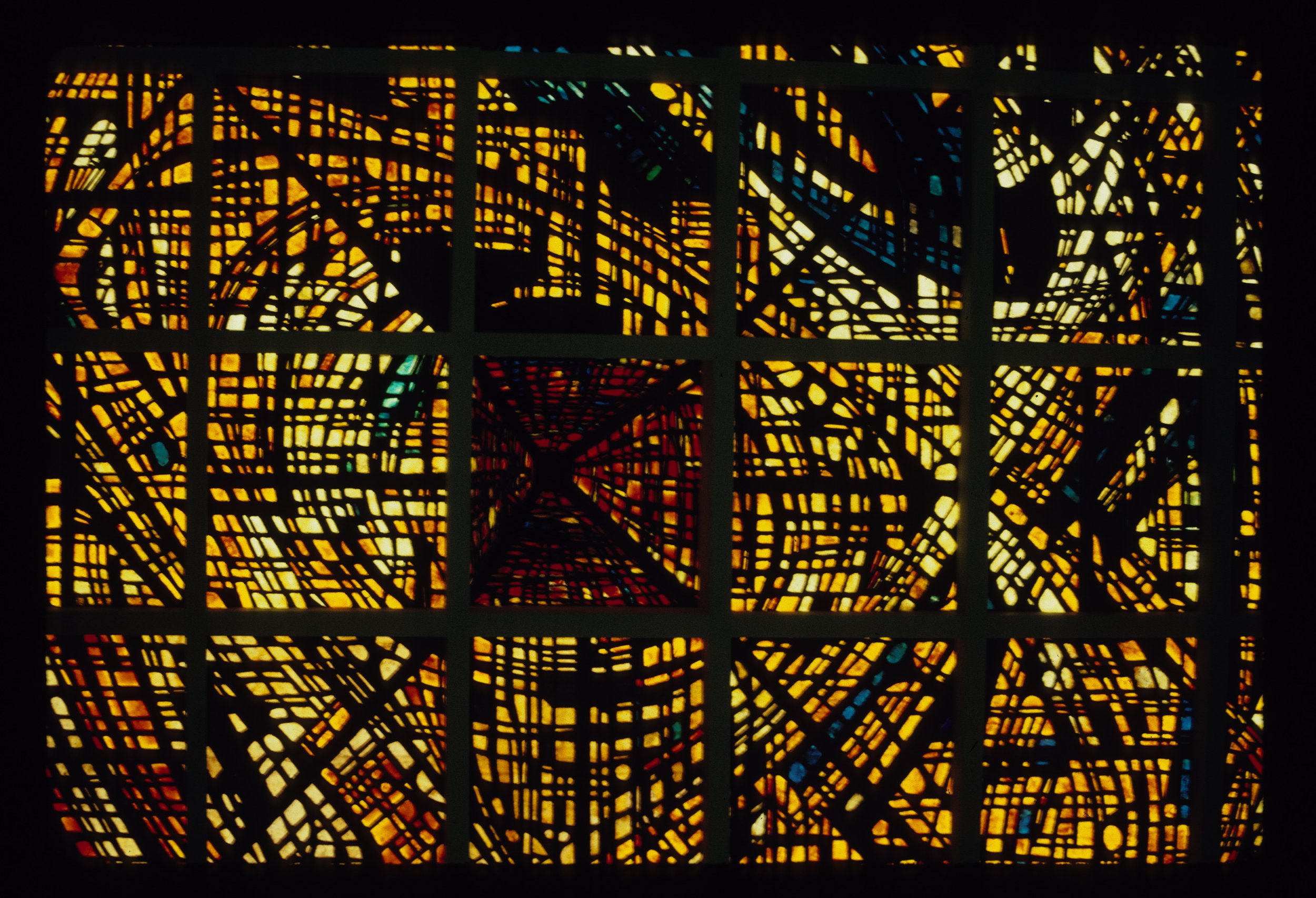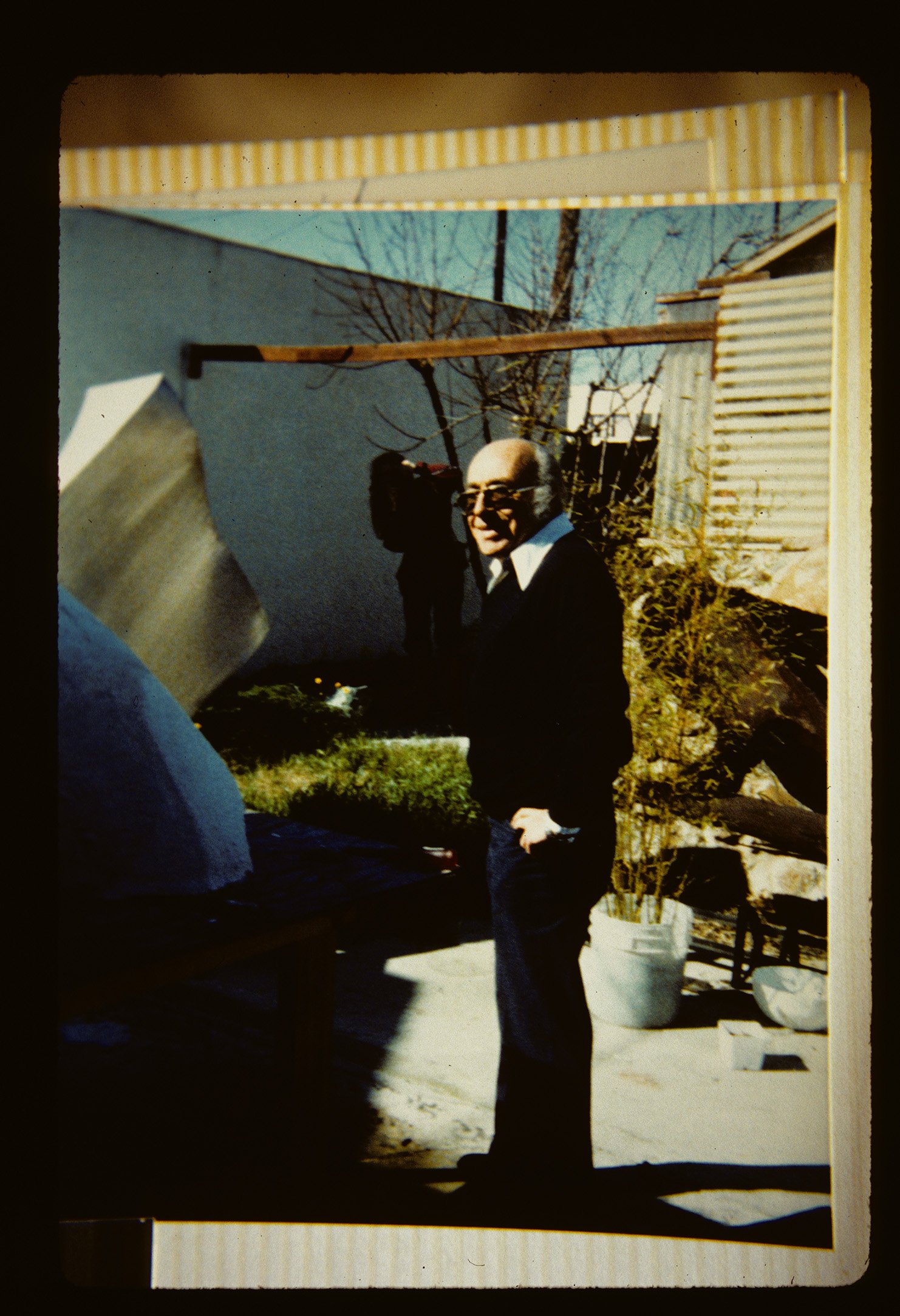















Roger Darricarrere was a French Sculptor and glass muralist who had a productive and influential career working primarily in Southern California until his death in 1983 at the age of 72. His glass work in particular was noted for its bright colored, textured, rough edge abstraction. He introduced the dalle-de-verre technique to the United States and was an innovator in studio glass making.
Born in Bayonne, France to a well off Basque family with turpentine interests he showed early talent in the arts. At age 19 he was one of ten finalists in a poster competition with Picasso. He attended a local art school followed by the Ecole Nationale Superiure des Decoratifs de Paris, studying drawing, painting, and sculpture, majoring in industrial and architectural design. He was included in the 1936 exhibition at Salon de l’Art Mural that also featured Picasso, Miro, and Juan Gris. The show expressed the Modernist desire to use the mural as a functional adjunct to the new architecture emphasizing the pained surface rather than pictorial three-dimensional illusion (l). He was voted one of twenty outstanding painters by the Visconti Gallery in 1946.
During the early war years Darricarrere saw service in the Engineering Corps of the French Army. After being discharged, from 1940-3 he did research on folk arts and crafts at the Musee des Arts et Traditions Populaires in Paris. In 1943 he joined he Free French Army of d Gaulle doing under cover work. (He would tell stories about riding on his bicycle, charming ladies, gathering information; his code name was Dominic.)
Immediately after the war he organized a craft school for veterans. This eventually led to a 10 month job as an interior designer in Cedar Rapids, Ohio. In 1951 he was hired by Goodyear Rubber Company in Los Angeles, where artists and painters were being hired to do technical drawings of furniture. Darricarrere found it boring, but realized it gave him resources to experiment and research the use of glass and concrete, and then open his own studio in downtown L.A. in 1952.
In 1955 he bought an ongoing stained glass studio, Glore Glass, that made primarily diamond lights and painted church windows, employing a dozen people. It was during this period he collaborated with two Northern California studios to produce the Holy Cross Lutheran Church (Los Gatos) windows in the dalle-de-verre technique. Both Cumming and Hogan Studios went on to make many windows in this technique.
Darricarrere soon moved the studio to more spacious quarters on San Fernando Road. This period was extremely prolific resulting in many church commissions (over 70 documented), as well as glass and sculpture commercial installations. He then met an interior designer, Adelle Faulkner through work in a Design Show ’56 at the Pasadena Art Museum. This resulted in a huge concrete and glass wall at the Lytton Savings and Loan office building in Los Angeles. Bart Lytton became a patron of Darricarrere’s commissioning notable glass and bronze sculpture for his banks and for his personal collection. A light projecting glass and metal sculpture, “Special Kaleidoscope” was commissioned for the Lytton Visual Arts Center. However, with Lytton’s death in 1969 signaled an end to Darricarrere’s most prolific period.
In 1968 Don Fairbanks, who had been a student and was then working in a Disney design studio, joined Darricarrere in a partnership. Darricarrere’s interest in glass waned and he devoted more time to his metal sculpture and leaving the major part of the execution of the stained glass to others, though still designing. Fairbanks bought the rest of the studio in 1977 and Darricarrere continued to design occasional windows from his sculpture studio in Venice (L.A.).
As a personality Roger Darricarrere was a charming and dynamic teacher who had little patience with people who put blocks up to getting things done. He felt freed in Los Angeles as the environment allowed him to use his multiple talents. He brought the Renaissance man view that you could paint and sculpt in stained glass. This contrasts greatly with the traditional European studio where the work was strictly compartmentalized—designer never crafting. Although he was extremely unscientific in his glass making—never saw any factories or read any technical books (so he claimed) he was always ready with advice and information of his own discovery. As an artist who knows his own talent he seemed harsh sometimes to those around him. He was afraid of losing what he had built. All his employees tell of horrendous arguments—but at the end of the day he had a good heart and was totally passionate for his work.
To his family he was something of a black sheep and he never spoke of his early years. He was married briefly but seemed rather closed emotionally. He was not a notable businessman, either, sometimes selling huge jobs too cheaply. He tended to shun peer group activities and professional organizations to his detriment. When a well established architect came to him for a panel for his office, Darricarrere quoted a ridiculously high price shooting down a potential long-term relationship.
Roger Darricarrere was one of the first practitioners of the dale-de-verre technique in America and probably the only one to use his own glass in his projects. Meaning brick of glass in French one to two inch thick cast, colored glass cut on pattern and embedded in a concrete and bracing bar matrix to make a structural panel. The inside surface of the glass may be chipped away and this is referred to a faceted glass. This gives a bright shimmering effect to the light. Commercially the colored glass is available in 1 x 9 x 12” slabs. The relatively small size of the available glass to the architectural scale for many of the windows gives a mosaic effect. The dalle-de-verre style was popular with church designers in Europe and America for its modern looking massiveness and its structural integrity. The decline of post-was church building and the revival of leaded glass have contributed to a decline in the recent popularity of dale-de-verre.
Roger Darricarrere’s work was characterized by extremely brilliant colors, frequently unrelieved by ambers or grey, rough raw texture in the glass and on the surface of the bronze and concrete He favored broad sweeping gestural lines and chunky, primitive, bold forms in his sculpture. “I love color and brilliancy,” he is quoted as saying… “For strength and boldness in design, I use black glass. In sculpture, lots of combinations are possible with glass and metal, or with other materials.” (2) The style corresponded to an exuberant rough-hewn modernism which peaked in popularity in the 60’s. Events and new ideas of the seventies looked to cooler expressions and subtler decorations.
Two of Darricarrere’s more interesting stained glass commissions were the U.S. Life ceiling and The Light of the World Window.
The ceiling is a field of wildly gyrating cycles of lines across 1200 square feet of amber yellow, orange and blue dale. Set in concrete the glass has a powerful presence fifty feet above the lobby floor. The job making the six by six foot panels included strength testing for the building department. The shimmering facets blanket the lobby with light.
The Christ, The Light of the World window, was displayed at the New York World’s Fair in 1964 and is now installed at St. Stephan’s Lutheran Church in Granada Hills, California. It is a leaded window that uses very bright blown glass colors and huge lead lines zipping through the 40 foot space. Darricarrere published a description of the abstraction:
…The creation of the world—deep violet at the left suggestion the darkness—then the orange and yellow for the Universe—and God divided the Light from the darkness.
…at the right of the earth—green suggestion for God said let the earth bring forth grass’…following the curved lines at the bottom, a suggestion of water and fish
…Near the baptism of Christ, a tache of red color – a symbol of a demon trying to tempt the Christ… Two large white taches of color surrounding a golden element… Suggesting the second coming of Christ surrounded by Angels
It is an interesting attempt to merge the abstract modernist mural with religious symbolism.
INFLUENCES
The early years of the twentieth century was one of the most exciting periods on the history of art, and certainly a stimulating one for a young talent from the countryside. By 1932 when Darricarrere arrived in Paris, modernism in sculpture and painting had been building to a crescendo for fifty years. Cubism, the quintessential modern movement had already one through its complete development and its stamp already gone through its complete development and its stamp on the ars was very strong.
Picasso had from before 1909 combined the elements of primitivism and cubism in his sculpture. By the thirties he also included constructivism. Matisse had furthered the art f bronze with his bas-relief series, Back I-IV of abstracted figures in 1909-14. This had extended an exploration started with the expressionistic Balzac sculpture by August Rodin.
The work of the Russian constructivists Malevich and Tatlin among others. Malevich had been working on his Suprematism in 191 influencing sculpture away from casting and carving and toward the use of constructed separate elements.
The de Stijl movement was under the leadership of Teo van Doesburg in Holland. Their style was one of cool clean rectilinear designs that was both took from and gave to the rising school of modern architecture. The architectonic sculpture of Georges Vontongeroo in the early twenties carried the image of cubist constructivism.
The ferment of the time in painting was incredible. In addition to Picasso and Matisse the bold use of gesture organically derived of Kandinsky must have had an effect on the young Darricarrere. The outbursts from the volatile German scene penetrated to Paris. Kandinsky the Russian, found his home and style in Munich and showed in Paris. He had found sources in the Jugendstil movement, the art nouveau of Germany.
Joan Miro had a style that also affected Darricarrere. He used black as a strong positive element in his panting; Darricarrere’s debt to Miro can be seen in the black sun in the world’s fair window and his heavy use of black glass and black space in his oeuvre.
Chagall’s use of bright, intense, an primary color can be seen to have influenced Darricarrere. In addition Darricarrere had respected Chagall personally and saw he career as something of an ideal, a great painter who did some work in glass. Darricarrere tried to buy the leftovers of special glass that had been made for Chagall.
An artist Darricarrere had mentioned repeatedly was Fernand Leger. This humanizer of the machine and patient teacher of strong hand was a consistent advocate of his own personal modernism. Although influenced by cubism he was sometimes called a Tubist because of the mechanically shaped tubes he used in his painting. The Disks and The City complete in 1919 after endless sketches and variations used bright harmonizing colors, simple cubistic shapes and bold use of black as a positive element. Although he is quoted as saying, “For me the human figure has no more importance than keys or bicycles” (3) he never forgot the importance of the human element. The machine age was humanized by man’s feelings. He had been influenced by Byzantine mosaics, the painters David, Cezanne, Douanier, Rousseau. He had a bold vision of flat surface color. Never carried away by the “isms” his paintings have a certain dimensionality. In addition to teaching Leger designed theater sets, ceramics and stained glass.
Developments in architecture also profoundly influenced Darricarrere. Antonio Gaudi was active I Barcelona building his individualistic buildings. Heavily cast concrete decorated with inlaid mosaic using the form of parabolic arches characterized Gaudi’s break from the beaux arts norm of the 1880’s. His extreme textures and fluidity of overall shapes were a radical departure from the smoothly stylized architecture of the time.
Frank Lloyd Wright had lived in Germany for several years before World War I, and can be seen to have influenced the de Stijl group and even Le Corbusier. Gerrit Reitveld’s sideboard of 1919 has the lines of early Wright building. In the twenties in the U.S. Wright did a series of houses mostly in Los Angeles that were based on modular case block designs. Some of these were even perforated to allow light through. B the forties Wright had done the walls of Southern Florida University embedding pressed, colored geometric shapes into molded concrete in a way strikingly similar to how Darricarrere eventually worked.
Le Corbusier, the great French architect had used cast concrete in his buildings from the early hears of the century. The boxy concrete forms were left unfinished paving the was for concrete to be used raw as a building material Notre Dame du Haut in Ronchamp,
Le Corbusier’s project from 1950, combined sweeping use of formed concrete massive textured walls and perforations set with thick chunks of glass.
In the early thirties Labouret-Chaudiere started experimenting with thick (1-2”) blocks of glass set in concrete. This became known as the dalle-de-verre technique of stained glass. It reached its peak in Europe after 1945 with the huge dalles of the Bousois factory as shown in the French monastery church of St. Joan of Arc near Belfort by Jean-Luc Perrot.
In addition blown glass artists in France had produced stunning works in small factories from the 1880’s. Emil Galle and Rene Lalique made art nouveau style glass and set the tone for quality. The work of the Daum Family factor has been produced continuously since then with great creativity in the early years. Maurice Marinot was a studio artisan who took massive blown objects and deeply etched them in a unique modern style.
Roger Darricarrere had a successful and productive career although he may not have lived up to being one of twenty outstanding painters of 1946. His contribution to the art of stained glass and the studio glass movement was substantial thorough his innovative use of glass and work of his students. He was a product of his times being steeped in European modernism and building a career of architectural art in post-war Los Angeles.















